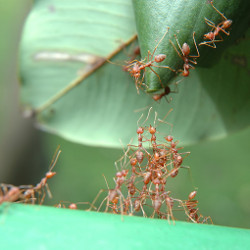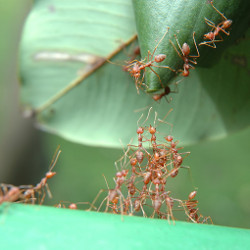
Intelligent patterns and behaviors appear in many living systems—and the collective behavior of groups such as birds or insects frequently display greater intelligence than any given creature. What one ant, bee, or bird cannot tackle alone, the group can, and often does, accomplish.
This shared intelligence has not gone unnoticed by robotics researchers. As they look for ways to build smarter mechanical objects that can creep, run, swim, and fly, they are turning to nature for inspiration and direction. Drawing on areas as diverse as biology, psychology, physics, materials science, and aerodynamics, they are exploring ways to create new and smarter robotic systems, including microbots that could someday venture into the human body.
“The field is very important, especially for large-scale applications such as environmental monitoring, search and rescue, agriculture, exploration, and crisis response,” says Katia P. Sycara, the Edward Fredkin Research Professor of Robotics at Carnegie Mellon University. “A swarm is a large group of robotic devices—into the hundreds or thousands—that can perform various useful large-scale tasks. Swarms can also remain robust with the loss of individual members.”
Of course, swarm robotics is not without technical and practical challenges—and it introduces new risks, such as the ability to use systems in wars and for autonomous killing. Yet, recent research demonstrates the concept is increasingly viable. “In many task settings, large solitary robots are about to give way to robot collectives capable of more complex behaviors,” says Kirstin Petersen, an assistant professor of electrical and computer engineering in the College of Engineering of Cornell University.
Second Nature
Drawing inspiration from nature is at the center of swarm robotics. “If you examine an army ant, each one is very simple and can do very little on its own,” observes Steven Ceron, a Ph.D. candidate and researcher in the mechanical engineering department at Cornell University. “However, when you look at what an entire colony can do, it’s pretty remarkable.”
“In many task settings, large solitary robots are about to give way to robot collectives capable of more complex behaviors.”
For example, a group of ants can work collectively to build a bridge with their bodies to allow other ants to cross over a stream. Similarly, bees communicate with each other about food sources that allow a colony to flourish, and many types of migratory birds fly in formations that benefit the group. The birds at the front reduce the drag for others behind them and, periodically, the birds switch positions so no single bird bears the entire brunt of the workload. “The collective group has an intelligence that exceeds any individual animal,” Ceron says.
Understanding the exact mechanisms that allow these social frameworks to flourish is no small task. “These are complex systems rooted in behavior and physics,” states Gaurav Gardi, a Ph.D. student in the Max Planck Institute for Intelligent Systems in Stuttgart, Germany. As a result, researchers study a wide range of natural systems, including magnetism that animals use for navigation, radio waves (such as 5G, Wi-Fi and Bluetooth) that simulate forms of animal communication, and the use of light, sounds, air pressure, and chemicals that could contribute to greater collective intelligence.
At the center of this concept is a different way of thinking about computing and communication, Sycara explains. Traditionally, computing and robotics models revolve around a central coordinator or “brain” that runs a system. However, in order for a swarm to function effectively—and without direct communication and control—intelligence must be distributed and decentralized, much like a colony of ants or a hive of bees. This requires local interaction laws and complex algorithms that can analyze and understand numerous situations and scenarios, including the loss of some units of the group.
The good news, Sycara says, is that nature and computer algorithms align reasonably well. “Currently swarm algorithms are based on control theory, but could be further enhanced by AI-powered algorithms. These swarms could be designed with decentralized algorithms that enable the individuals of a robot swarm to communicate with each other, adapt to an uncertain environment, and build consensus on situational awareness through local interaction laws,” she says. This decentralized model also offers the advantage of making it harder to trick or manipulate a robot swarm into doing something it is not designed to do.
In a swarm model, Petersen says, it is imperative to imbed pieces of intelligence on each device, but also to create ways for individual robots to share knowledge both directly and through mechanical and physical interactions. This means individual components might carry part of the code required, and in some cases they might carry duplicate code. Devices could share and swap information as needed.
“You can program a lot of the intelligence onto the morphology of the robot, similar to the concept of form and function in nature but using communication to handle other parts of the task, including updating and changing behavior dynamically,” Petersen says.
Minding the Group
Collaborative robotics is beginning to take shape. For example, researchers at Harvard University’s Wyss Institute have developed an autonomous robot swarm that can replicate the motions of fish. It accommodates individual decision-making, but also supports collective behaviors that benefit the entire school/swarm. These so-called Bluebots, part of a Blueswarm of 1,000 “fish,” are each equipped with two cameras and three LED lights. Tiny onboard cameras detect the LEDs from neighboring Bluebots and calculate their distance, direction, and heading with an onboard algorithm.a
The robots in a swarm “can impact and affect each other and create an emergent complexity that exceeds the sum of the individual parts.”
Through the use of implicit rules and three-dimensional (3D) visual perception, researchers were able to build a swarm system that has a high degree of autonomy and flexibility underwater, where GPS and Wi-Fi generally are not accessible.
Another group of researchers have developed tiny 3D-printed circular micro-robots, each approximately the width of an averaage human hair. The devices, made from polymer material coated in cobalt and surrounded by wire coils that function as tiny magnets, make it possible to tune and reconfigure the group on demand within an air-water interface.b The micro-robots were created by Wendong Wang, an associate professor at the University of Michigan-Shanghai Jiao Tong University Joint Institute in Shanghai, China, who collaborated with Petersen, Ceron, Gardi, and Max Planck Institute professor Metin Sitti.
The project further demonstrated the viability of swarm systems. The researchers made 120 micro-disks form chains, locomote through magnetic field gradients, perform contact-based and flow-based object translation and rotation, and explore an open space through gas-like self-propelling microdisk pairs. The behaviors were triggered through several processes and actions, including hydrodynamic, capillary, and magnetic dipole–dipole interactions controlled by external magnetic fields.
Depending on how the researchers changed and adapted the magnetic fields in relation to fluids and air, they could manipulate the disks to attract or repel each other, Gardi says. This ultimately led to six different collective behaviors that that have applicability in the physical world. The team also demonstrated the viability of breaking groups into smaller subgroups with more specialized functionality.
Although magnetism is an obvious choice for linking and controlling micro-robotic devices, Gardi points out that light, sound, electric fields, radio waves and virtually any other type of physical force could be used. Moreover, the combination of these forces—and the different interactions they create—could introduce an array of functions and features that deliver a range of capabilities. “They can impact and affect each other and create an emergent complexity that exceeds the sum of the individual parts,” Petersen adds.
Of course, developing functional robot swarms involves several other key areas. Sycara’s research, for example, has focused on understanding human-swarm interactions, vulnerabilities of robot swarms, how different swarms might interact (in friendly or adversarial ways) when they come into contact with one another, and how to apply swarms to actual situations, such as fighting fires and rescuing people. This might involve physically coupling individual platforms into flexible swarm configurations, like creating swarm ropes to rescue people from burning buildings and assembling robot platforms that can transport people to (or from) hard-to-reach spaces.
“Transferring ideas from nature and physics into electronic systems has many layers of complexity.”
Not surprisingly, a critical area of concern for researchers is failure rates for swarm devices. While it may be acceptable in some situations to have 40% or even 50% of the robots cease to operate correctly, this isn’t satisfactory for things like swarm ropes and robotic rescue ladders. Thus, there’s the need for backup communications protocols and the ability for the devices to operate independently.
However, Petersen points out, as the number of robots in a swarm scale upward and as they start to depend on physical interactions to produce emergent behaviors, the aggregate volume of malfunctions and failures can take a toll. “If you have 1,000 robots and half fail to affect the environment correctly, it might severely impact the ability of the collective to accomplish a task,” she explains.
Into the Swarm
Solving these challenges and building viable robot swarms revolves around the broad array of disciplines, Petersen says. For example, about 30% of her research team is comprised of biologists, but there’s also a need for mechanical and electrical engineers, computer scientists, and even sociologists and psychologists. “Transferring ideas from nature and physics into electronic systems has many layers of complexity,” she points out.
Nevertheless, several companies have used orchestrated aerial drones—in some cases several thousand at a time—to create elaborate light shows in the night sky. For example, South Korean company Genesis, a division of auto company Hyundai, deployed 3,281 drones to announce its entry into the Chinese market in April 2021. They displayed the company’s logo above the city’s harbor in what was described as a breathtaking display.c
Researchers say that within a few years, robot swarms could tackle a variety of tasks. They might rely on a few larger robotic devices, several insect-sized devices, or even nanobots that venture inside the human body to dispense medicine or handle other delicate tasks. They could search through rubble and handle repairs underwater and in other hard-to-reach places. Petersen believes swarms could be used for automated construction and managing crops. “Co-operative robots introduces a remarkable array of opportunities,” she says.
While researchers express some concerns about the ethical use of swarm robotics—including their use by the military for lethal autonomy—the technology continues to march, swim, and fly forward. A growing understanding of nature, along with knowledge of how to translate sensory data and environmental awareness into robots, promises to revolutionize the space in the years ahead. Says Petersen: “As smart materials advance and our ability to design and build devices and algorithms grows, swarm robotics will move out of the research lab and into the real world.”
Gardi, G., Ceron, S., Wang., W., Peterson, K., and Sitti, M.
Microrobot collectives with reconfigurable morphologies, behaviors, and functions, Nature Communications, 13, Article number: 2239, April 26, 2022. https://www.nature.com/articles/s41467-022-29882-5
Berlinger, F., Gauci, M., and Nagpal, R.
Implicit Coordination for 3D Underwater Collective Behaviors in a Fish-inspired Robot Swarm, Science Robotics, Vol. 6, No. 50. Jan. 13, 2021. https://www.science.org/doi/10.1126/scirobotics.abd8668
Nam, C., Walker, P., Li, H., and Sycara, K.,
Models of Trust in Human Control of Swarms With Varied Levels of Autonomy, IEEE Transactions on Human-Machine Systems, Vol. 50, Issue 3, June 2020. https://ieeexplore.ieee.org/abstract/document/8651317
Bredeche, N. and Fontbonne, N.
Social learning in swarm robotics, The Royal Society Publishing, Volume 377 Issue 1843, January 31, 2022. https://royalsocietypublishing.org/doi/full/10.1098/rstb.2020.0309





Join the Discussion (0)
Become a Member or Sign In to Post a Comment